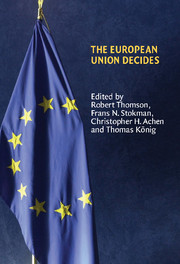Book contents
- Frontmatter
- Contents
- List of figures
- List of tables
- Notes on contributors
- Preface
- 1 Explaining legislative decision-making in the European Union
- 2 Research design: measuring actors' positions, saliences and capabilities
- 3 Testing procedural models of EU legislative decision-making
- 4 Institutional realism and bargaining models
- 5 Compromise, exchange and challenge in the European Union
- 6 Nash versus Schelling? The importance of constraints in legislative bargaining
- 7 A cooperative approach to decision-making in the European Union
- 8 A procedural exchange model of EU legislative politics
- 9 Beyond informal compromise: testing conditional formal procedures of EU decision-making
- 10 Evaluating political decision-making models
- 11 Evidence with insight: what models contribute to EU research
- Appendix I Selection of Commission proposals
- Appendix II Comparison of expert judgements with each other and with information from Council documentation
- References
- Index
- Title in this series
4 - Institutional realism and bargaining models
Published online by Cambridge University Press: 22 September 2009
- Frontmatter
- Contents
- List of figures
- List of tables
- Notes on contributors
- Preface
- 1 Explaining legislative decision-making in the European Union
- 2 Research design: measuring actors' positions, saliences and capabilities
- 3 Testing procedural models of EU legislative decision-making
- 4 Institutional realism and bargaining models
- 5 Compromise, exchange and challenge in the European Union
- 6 Nash versus Schelling? The importance of constraints in legislative bargaining
- 7 A cooperative approach to decision-making in the European Union
- 8 A procedural exchange model of EU legislative politics
- 9 Beyond informal compromise: testing conditional formal procedures of EU decision-making
- 10 Evaluating political decision-making models
- 11 Evidence with insight: what models contribute to EU research
- Appendix I Selection of Commission proposals
- Appendix II Comparison of expert judgements with each other and with information from Council documentation
- References
- Index
- Title in this series
Summary
THE TWO STAGES OF POLITICAL DECISION-MAKING
Close studies of governmental decisions in democracies commonly divide the process into two stages. First, the actors bargain. As Arthur Bentley (1967 [1908]: 371) put it nearly a century ago in describing the legislative process, ‘It is compromise … It is trading. It is the adjustment of interests.’ This stage may include information-gathering and exchange, as well as threats and promises. Few rules constrain the actors. The free-form interplay puts a premium on creative interpretations and skilful compromise.
Then, when deals have been struck (or the parties to the conflict are exhausted), the second stage takes place. Here the organisational regulations and legal rules shape the process, and a test of strength is carried out according to constitutional or legal procedures. Explicit voting procedures settle differences of opinion.
The two stages of political decision-making interpenetrate and influence each other. Groups with more votes in the constitutional procedures have more power in the preliminary bargaining. Conversely, skilful bargainers at the initial stage may persuade other actors and build coalitions that control a disproportionate number of votes at the final stage. Manoeuvring at each stage takes account of the contending groups' power at the other stage. A sophisticated recent discussion that emphasises this two-step view of European Union decision-making is Van den Bos (1991, chapter 5). Students of domestic politics have repeatedly discovered the same process at work, particularly in studies of interest groups, ‘iron triangles’, policy networks, and issue coalitions.
- Type
- Chapter
- Information
- The European Union Decides , pp. 86 - 123Publisher: Cambridge University PressPrint publication year: 2006
- 57
- Cited by



